Terry Brooks is known to collectors of heavy psych rock for his Translucent World (1973) and Raw Power (1976) albums, released under the name Strange (later reissued as Terry Brooks and Strange). But digging deeper into the life and work of this gifted guitarist, artist and author reveals a fascinating tale of a man who was ahead of his time as a musician, and one who took control of the pressing and releasing of his albums in the days before such endeavors were common.
Though “heavy psych” is the tag typically given to Terry’s music, attentive listening across several albums reveals a deep space quality and distinctly personal guitar style that is simultaneously cosmic and manic, other-worldly and molten lava rocking. For Terry Brooks the guitar solo is sacred. Solos frequently dominate entire tracks, though far from being self-indulgent, the solo is for Terry a means of articulating the very essence of his soul.
A native of Florida born in 1942, by the early 1960s Terry was already playing professionally, travelling the US as the only white musician in an all-black Blues band on the so-called “chitlin’ circuit”. The spaced out guitar effects on the 1973 Translucent World album recall contemporaries like Hawkwind and Guru Guru. But Terry was unaware of these bands and, crucially, points out that he had worked out such sounds many years before, describing a brand of Blues Space Rock he was playing in 1960. “I had a Gagnavox or Magatone amp. At the end of the shows I would do a kick ass sound effect guitar solo. I would beat my fist on the amp and start over-loading the amp which caused me to play feedback. I would say now let’s go to a new dimension in a different time zone. People would wig out at the end. I would get down on my knees and play, throwing my head around, picking a couple notes on my Fender Jazz with my teeth. People went crazy over that. I had long hair for the time. I would crawl over to my amp spotlight and go tight on my hand on the amp, switch a strong feedback note that would play for about 60 seconds.”
In the later 60s Terry ended up in the army and, consequently, Vietnam. It’s clear from our email exchanges that Terry experienced the worst imaginable horrors of war, and the time he served left him with Post-Traumatic Stress Disorder (PTSD), something he struggles with to this day. “My whole life was destroyed in Vietnam. It tore my heart out and melted my brain, but at the same time gave me great love for all that is part of this cosmic vessel I ride in. I love life and grieve the greed and destruction I see today.”
Back in the US, Terry released Translucent World in 1973 on his own Outer Galaxy Records label, having turned down a potentially lucrative RCA contract due to record company pressures to change his style. While self-releasing albums wasn’t unheard of in those days, it was far from common and those bold enough to do so faced considerable distribution challenges. One major setback involved the destruction of several thousand copies of Translucent World when a Miami distributor’s warehouse burned to the ground and filed bankruptcy due to not having insurance.
In the three years between the release of Translucent World and Raw Power, Terry continued to struggle with PTSD and taught guitar at a music school. When asked how he overcame the challenges of running an independent record label in the early 1970s, Terry credits enlightened radio station DJs who, unshackled by the major record company payola system, championed his music. “I cut Raw Power to revitalize the energy of my music and fan base. Well people loved that LP. The cosmic message was a bit strong for the masses but still DJs were on my side.” One thousand copies of Raw Power had been pressed and Terry soon started to receive letters from DJs in the US and Europe, as well as record labels in the UK, Germany, and Italy wanting to release his music.
Listening to the music on Translucent World and Raw Power it’s no wonder that Terry would have caught the attention of DJs and their listeners. The music is visceral and explodes with wild-eyed passion. The raw energy of Terry’s music is also the product of an intuitive feel for what he is trying to communicate that results in a no nonsense approach to recording. “My life was love of music and all things that are and ever would be in the form of energy and light waves. The vibrational force would take over my mind and body. All albums I have done were first cut no add tracks. I would sing and play the songs in one take only. Most of the time the album would be played one take in one hour. Bang, it would be done and then go in to mixing and finish in one day, master the LP the next day.”
Bruce Hensal is a recording engineer who has worked on major label albums by such artists as The Eagles, Boston, Allman Brothers, Bee Gees, Rolling Stones, Joe Walsh, Eric Clapton, and many more, but has also engineered some of Terry’s albums. When asked how working with Terry compared with sessions by The Eagles or Boston, Hensal supports Terry’s description of his recording process: “You are right about Terry’s studio work being the complete opposite of an Eagles/Boston session, where each detail was worked out, different ideas/sounds tried and many attempts at a performance were tried. Terry came in with the songs written and the parts worked out and rehearsed. The solos were spontaneous, but were almost always done in one continuous pass. Terry is an extraordinarily gifted guitar player and it was a pleasure working with him and the band. This kind of inspirational recording leads to a passionate and spontaneous performance.” Terry also eagerly credits his guitar, custom made and gifted to him by Michael Tobias of The Guitar Shop and Bill Fels of The Guitar Factory, both in Orlando, Florida.
After a hiatus from music, Terry returned to recording and touring in the 1980s and 1990s. In an effort to paint the fullest possible picture of the music, what follows is a catalog review of all Terry Brooks albums, with the exception of the compilation releases No Exit and Blastin’ Thru, both released in 1984 and which Terry describes as jam tracks. I also discuss Terry’s novel, Father Rock.
 Strange – “Translucent World” (Outer Galaxy Records 1973, later reissued by Psycho Records and then Akarma Records)
Strange – “Translucent World” (Outer Galaxy Records 1973, later reissued by Psycho Records and then Akarma Records)
The debut Terry Brooks album is credited with the band name Strange, though reissues included the label Terry Brooks & Strange. The albums opens with Jimi, pummeling the listener with raw crashing power chords and solos that are so manic you might envision a man possessed. Terry’s vocals are a little different from the more screaming style of later albums, being characterized by a passionate, almost Jack Bruce quality. Though an ode to Hendrix, the music’s only relationship to the legend is its fit with the power trio style of the late 60s/early 70s and Terry’s adventurous use of the guitar, and across the album it becomes apparent that he has taken the spirit of Hendrix and incorporated it into his own trademark style.
Ruler Of The Universe is next and a song I consider an unsung Space Rock classic. It starts off in easy-paced heavy Prog fashion, with cosmic lyrics about people who come from the stars. It then goes into an instrumental segment, with Terry soloing in his wild but expressive style. But then at the 6 minute mark of this 11 minute track, Terry goes into deep space, cranking out swirling and screaming effects that sound like a UFO in distress. A truly mind-blowing, expansive track that is characteristic of, yet beyond its time. And while it’s interesting to note that Translucent World was released the same year as Hawkwind’s Space Ritual album, it bears repeating that Terry had not heard of Hawkwind at this time. “The solo of Ruler Of The Universe was guitar echoplex voices, it was the feeling of the combat of the universe.” Once again crediting the DJs who were so crucial to promoting his music, Terry says, “DJs would say – and now the father of cosmic rock, Terry Brooks and Strange. This was the DJs way of saying Terry has been there before the rest and he is a major influence in the music world and still is today. A lot of artists took his style and energy to influence their music.”
Rounding out the album are such tracks as The Kiss Of A Butterfly, on which Terry demonstrates his flair for slower, almost ballad-like songs that include intense solos which fit seamlessly with the music and mood. Even this relatively short 5+ minute song has an epic quality, transitioning through several themes. Hey Mr. Lonely Man is a soulful tune, with what continues to reveal itself as Terry’s trademark epic quality. Lost opens with a light, cosmic, meditative atmosphere, with expressive, ever changing guitar, organ, piano, and emotional vocals – “Take the train of life, keep on rolling, I’ll keep on rolling till the end”.
The Akarma Records reissue of Translucent World that I own includes two bonus tracks. One, from a live performance, is a cover of Willy Dixon’s Spoonful and is a killer take on this Blues classic. Terry alternates between traditional acid-Blues, cosmically Hendrix drenched guitar, and his own ballistic take-no-prisoners runs. And Preacher Of Rock ‘N’ Roll is a studio track that sounds like just guitar, organ and electronic drums, and is a passionate testament to Terry’s belief in the power of ROCK.
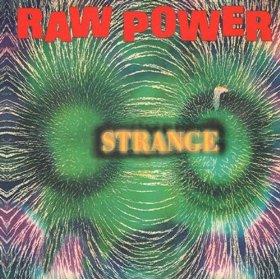 Strange – “Raw Power” (Outer Galaxy Records 1976, later reissued by Psycho Records and then Akarma Records)
Strange – “Raw Power” (Outer Galaxy Records 1976, later reissued by Psycho Records and then Akarma Records)
Terry’s second album, once again released as Strange, builds upon the cosmic psych rock introduced on Translucent World. Fields And Fields Of People is an easy-paced song with guitar licks that are slow and melodic until taking off for the finale. Are You My Friend opens with brief spaced out guitar effects, quickly shifting to whining, strangulation guitar, before settling into a stoned groove. Terry’s vocals trade off with his guitar as if the two were performing a duet. I love the combination of stoner guitar chords and Hendrix-like licks on this song. To The Far Side Of Time is a 3+ minute swirl of deep space guitar effects that’s like some cosmic storm brewing. Near the end we hear Terry’s voice speaking, though it’s backwards, and then BANG, we launch into the title track, which continues the total guitar motif and Terry going completely acid mind-fucked volcanic on the instrument.
After the eruption of the last two tracks, the bouncy rhythmic pace of Love Me is a bit of a shock. It’s an exercise in contrasts as Terry sings this catchy song with its “Who-Na-Na” vocals, yet also cranks out manic solo runs. Having been immersed in all these albums I’ve come to understand that the constant soloing works because of the expressiveness of Terry’s playing. No matter how manic the guitar, Terry is communicating with the listener and that’s because the guitar solo is very much an extension of Terry himself.
The highlight of the album is the 19 minute, sonic guitar assault anthem, Life Jam. The first 5 minutes are like an extended introduction, with Terry playing against a light drum beat backing. Then the band launch into a Hendrix styled jam, the rhythm section creating a slightly unbalanced marching groove which Terry wails along with. There’s a constant sense of tension throughout as the music builds to climactic peaks and holds the listener with a feeling that something is going to explode. Yet the explosion is on-going, like lava gushing steadily out of a volcano. At the core this is heavy acid rock ‘n’ roll, but with a Progressive Rock sense of thematic development and transition and emotional impact on the listener.
Bonus tracks on the reissue include Night Rocker, a down ‘n dirty rock ‘n’ roll song. And Rock ‘N’ Roll Queenie is a head banging metallic chunky rock ‘n’ roller and a classic example of what became Terry’s trademark screaming vocal style. While this was a significant departure from the vocals on Translucent World, it turned out to be a marriage made in heaven for his guitar style.
 Terry Brooks & Strange – “To Earth With Love” (Star People Records 1980)
Terry Brooks & Strange – “To Earth With Love” (Star People Records 1980)
Terry Brooks & Strange – “High Flyer” (Star People Recrods 1982)
** Both albums reissued together on CD in 2001 by Coda Records
Originally released as separate albums in 1980 and 1982, I’ve got the Coda Records 2-in-1 CD reissue of To Earth With Love and High Flyer. There’s a pretty clear thematic difference between the two albums. To Earth With Love eschews the long jams, being more focused on rock songs and ballads in the 3-6 minute range. But don’t think for a minute that that means a lack of in-yer-face guitar.
Bottom Line opens the set with a steady thumping rock beat, stinging, stoned guitar, spacey keyboards, and near-screaming get-outta-my-way-I’m-ROCKIN’ vocals. Woman is an interesting mix of Ian Hunter styled piano boogie, doom-laden Black Sabbath, and Terry’s own rip-it-up rock. And Mister Strange features more of that boogie-ish piano, but also intense guitar solos.
But with It’s A Beautiful Day we get something quite different from anything we’ve heard from Terry before. The 8 minute song begins as a pleasant melodic piano and vocals ballad with light orchestration. When Terry’s guitar kicks in the solo rocks, but is just restrained enough to fit the mood of the piece. As the song develops, the same ballad-like pace is maintained, while the guitar becomes increasingly aggressive and is an outstanding example of Terry’s ability to be manic and yet so passionately expressive. I Promise You My Love, Midnight Angel, and You’re All I Need are more beautiful piano dominated ballads. But then for the closing track Terry does a 360 degree turn with Down And Dirty Blues, which is EXACTLY what the title says. This is the most ass kickin’ blues I’ve heard from Terry since the Spoonful bonus track on Translucent World, featuring true balls-to-the-walls ripping Blues guitar. A killer closing number.
The High Flyer album kicks off hot ‘n heavy with You Will Be Loved, an acid-metal riff rocker with Terry screaming, “Around the world!!! Around the World!!! You will be looooooved, yeah you will!!!” A real brain fryer of an opening track. Then Terry goes Hendrix on Child Of The City, with crazy gymnastic trip guitar and a variety of effects, AND it’s got a great swingin’ groove. Terry maintains the relentless pace on Rock And Roll Women, a killer acid-drenched, take-no-prisoners rock and roll song.
Then he shifts gears for the remainder of the album. What Kind Of Man takes a tuneful melodic break, being a reflective song about assassins and war-mongers. My Lady And Me is a peaceful spacey song, sung in the first person by a visitor from another galaxy who, along with his “lady”, come to teach us about love. Love Of The Ages is another love song with a spacey vibe, and has a cool 60s pop feel. And the title track features another traveler from the cosmos telling his tale: “High Flyer is my name. High Flyer traveling through another time and plane.” The music has a space-Beat-jazzy vibe that I like and goes nicely with the lyrics. Terry’s guitar solo, one of his most sparse, makes every note count and reminded me of the Twin Peaks theme.
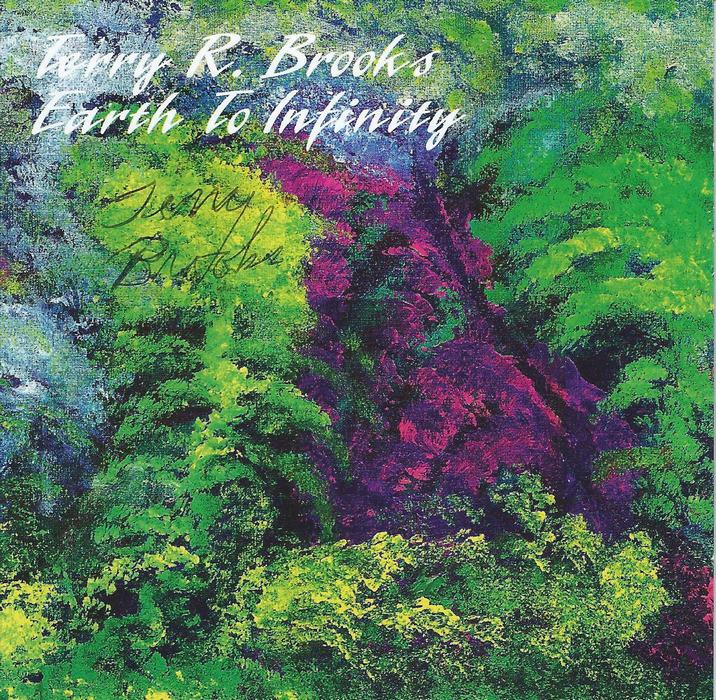 Terry R. Brooks – “Earth To Infinity” (Strange Records 1995)
Terry R. Brooks – “Earth To Infinity” (Strange Records 1995)
Fast forward several years to 1995 and we have the all instrumental Earth To Infinity album, which consists of some music that shows a different side of Terry’s musical personality. Winward Bound and Dream both feature an accessible, slightly heavy pop-oriented brand of instrumental Progressive Rock, the later including beautifully majestic screaming guitar alongside wailing sax licks. Sailaway is similar but with a jazzy vibe and has a dancey groove that at times has a Latin flavor, which is an intriguing combination with Terry’s guitar solo blazing along with it.
Spirit Of The Mountain is an uplifting anthem-Prog tune that conjures up images of an auditorium full of swaying bodies and lit bic lighters (NOT cell phones!). Mystic Love is an instrumental (and retitled) version of It’s A Beautiful Day that moves from floating, almost New Age passages to ripping guitar solo segments. This song puts an arrow right in the heart.
Now we switch gears for a bit. On Night Blues we get a brief piano and sax intro, after which Terry’s guitar steps in and we’re treated to a SASSY slab of big band Blues. The Blues continues on Stormy Blues but more deliciously dirty rocking, with kick ASS guitar and killer organ. Terry’s guitar just ain’t gonna quit as Stormy Blues leads into Flyer, a similarly Blues infused rocker with chunky metallic chords and swingin’ piano to augment the non-stop soloing guitar. Earth Star is another anthem rocker with spaced out atmospherics and reminded me of those Pink Floyd numbers when Dave Gilmour was at his most cosmic Blues rocking.
And then Terry closes the album with a completely different vibe. Space is a short synth and efx’d guitar soundscape trip to the cosmos that leads into the finale, the 9 minute Inner Peace. Together these two are very different from anything I’ve heard yet from Terry, being a meditative space journey created with synths and ambient guitar-scapes.
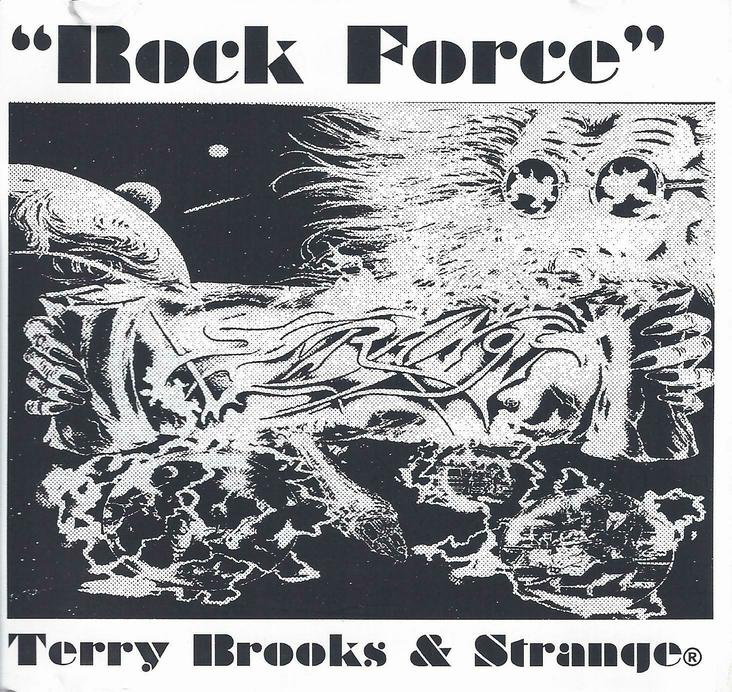 Terry Brooks & Strange – “Rock Force” (Strange Records, limited edition of 100 CDs)
Terry Brooks & Strange – “Rock Force” (Strange Records, limited edition of 100 CDs)
Released as a limited edition of 100 CDs, Rock Force is a compilation of unreleased, alternate version and live tracks recorded between 1980-1998. Giving a glimpse of the sonic assault to be heard is one of the descriptions on the back of the CD which reads: “This is a masterpiece of screaming vocals and ‘rip your face off’, ass kickin’ guitar runs. Turn it up loud and let Mr. Strange fry your brains.” And that’s exactly what you get on this monster set of heavy psych guitar and acid-metal blazin’ rock ‘n’ roll.
Rock Force and Are You My Friend are both fist pumping rockers that feature Terry’s guitar blasting out chunky acid-metal power chords and screaming solos and vocals. Rock And Roll Queenie and Night Rockers are powerhouse numbers that sound the same as the two bonus tracks on the Raw Power reissue. The guitar on Mystic Eyes is cosmic psych rocking exploratory with lots of jamming and features Terry’s patented wildman take on Hendrix. Both the guitar and lyrics are in deep space on Star Flyers, as Terry sings about the star flyers who travel the universe. Really amazing space rocking guitar on this song. And then we get two monster live tracks, both recorded when Terry toured Germany. Rock The World is a 21 minute blitzkrieg of incessant, insane, and totally mind-fucked guitar pyrotechnics. People without brain cells to spare should approach this with caution. But for those who can handle it, this is a tasty epic rocker. Child Of The City, the 5+ minute song from the High Flyer album is stretched out to 10 minutes on this live version, and picks up where Rock The World left off with lots of crazed rockin’ guitar to supplement the song. Rock Force is a fantastic compilation for those who want to ROCK with no break or breather.
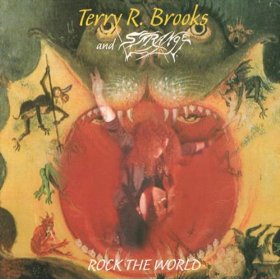 Terry R. Brooks & Strange – “Rock The World” (Akarma Records 1998, AK006)
Terry R. Brooks & Strange – “Rock The World” (Akarma Records 1998, AK006)
The 2-LP Rock The World set, released by Akarma Records in 1998, documents a 1980 concert in Orlando, Florida that was made up of songs from Terry’s 1980s and onward albums. Take the descriptions I gave about the live tracks on the Rock Force CD and know that that is precisely what this ENTIRE set is about. I have to believe audiences at these shows were left drained, catatonic, and wholly, blissfully satisfied. The album is available for digital download, but vinyl junkies should try to track down a copy because it comes housed in a beautiful gatefold, with thick-as-a-brick colored vinyl (one red and one lime green), and a poster.
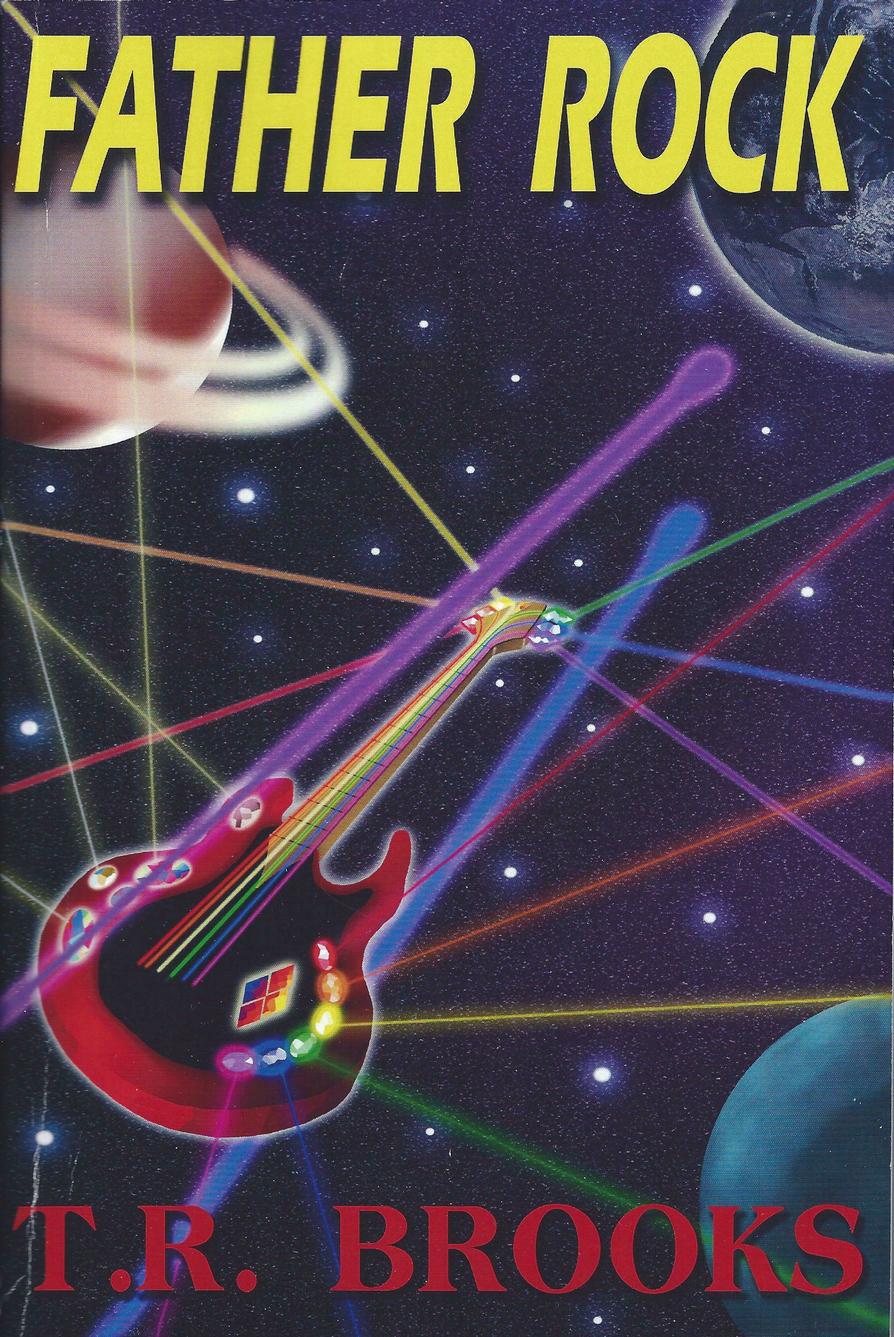 Father Rock (Novel, Trafford Publishing 2007)
Father Rock (Novel, Trafford Publishing 2007)
Terry’s novel Father Rock is an action-adventure, rock ‘n roll battle between the forces of Good and Evil, with nothing less than the survival of the universe at stake.
Robert, a high school student, wonders why the world can’t be full of people who do good things and help one another, and bemoans the pervasiveness of hunger, homelessness, and crime. Robert has a booth at a fair, displaying his artwork with representations of dimensional symbols. He meets a man, Dr C, who is fascinated with the symbols, pointing out that they are a quantum math form, and assembles others to help Robert decipher the symbols.
Robert sees a vision while in a trance in which he learns that he is Father Rock, who represents all good and positive forces in the universe. But Robert also sees figures in black satanic robes surrounding a sacrificial table, reciting chants to summon the evil Demos, who will face Father Rock in battle on planet Earth. Father Rock’s parents had been killed in an earlier battle with Demos when he was a boy.
To prepare for the battle, Father Rock and his growing group of followers form Team United Worldwide (TUW), whose mission is to unite good people around the world to right all evil. Father Rock is a white-haired robed wizard with a long white beard, described to the members of TUW as, “The ruler of the universe. He is the most dynamic guitar player that ever existed. He has always been and he will always be the force of all good that exists. He has great psychic powers. He is a philosopher, a genius of mathematics, a person who has come to Earth to defend the good forces of all existing things against the evil demon Demos. Father Rock’s weapon to save the world from evil forces is his laser guitar. It shoots laser beams and rockets and creates the sounds of the universe. He shall use his universal music to destroy all evil, and all that is evil in the universe comes from Demos.”
Heavy stuff indeed. So armed with his sonic cyber guitar, Father Rock goes into battle against Demos, whose weapon of choice is a keyboard. But the battle isn’t just mano-a-mano. Father Rock and Demos are each based on their own “stage” on either side of a mountain, and each is supported by his “band”, Father Rock’s TUW members and Demos’ various demons. After a raging battle Father Rock and TUW defeat and kill Demos, or so they think. The story then picks up 15 years later with the return of Demos and a new battle. Who will win this time? Read and find out.
Father Rock is a fun book and in many ways reads like a Power Rangers script. There are lots of colorful characters, like the Muzoids – Spark, Zap, Tink, Zon, and Electro, who are playful and childishly pranksterish, but highly intelligent, fierce warriors. And then there’s Goodtor, the Muzoid’s 60 foot tall robot (of course Demos has his own robot, Eviltor).
But while the story reads like a Power Rangers or some similar youth market tale, it’s important to understand that the book represents much of what has occurred in Terry’s life. As he explains, “75% of my life has been a conflict to survive. Father Rock had conflict to survive. Demos killed his mother and I look at Vietnam as Demos. My father killed himself for my part of a war that I did not want to be in. It hurts me every day and at night it is really bad. So I still fight the battles.” This is a book written by a man who experienced the horrors of war, and was saved, in part, if not wholly, by his music. And at least one of the characters is based on a friend of Terry’s – Dr C is the real life Dr Chisholm. Just as Dr C studied Robert’s mathematical symbols, Dr Chisholm studied the math language that Terry wrote.
Good vs. evil is among literatures most common themes, but it’s at the forefront of the entire story. The members of TUW are described as being unified in caring and love. “You are part of a team that cares about the salvation of our world and our universe and all existing things.” One character, Frankie, who Father Rock appointed as operations manager for TUW, is described at length: “He was trained in security, counter-terrorism, and combat. He was a black belt in several martial arts. But Frankie’s most appealing quality was his great compassion for humankind. He had dedicated his life to making the world a better and safer place to live. His moral integrity was unquestionable and he loved to work with young and old people.”
We also learn that Terry’s concern with good vs. evil is absolute, even extending to a willingness to destroy the world should evil triumph. “If Demos won the battle, a built-in termination switch inside Goodtor would automatically obliterate the entire world and everything in it. The team knew instinctively that if Demos ruled the world everyone would be better off dead.”
It’s interesting to read the descriptions of Father Rock, who comes across as a God-like figure. In battle he is able to heal the wounds of his team members and himself. When asked how old Father Rock is, the response is, “They say he has always been and he shall always be, he is the infinite one. He is timeless.”
In summary, we have a fun good vs. evil action-adventure, with more underlying meaning and insight into the author’s life than the writing style would suggest. Terry has been actively trying to get the book made into a film. I can envision it being handled in a number of ways. Just make sure the CGI budget is BIG.
For more information about Terry Brooks, which includes links to purchase digital versions of his albums and the Father Rock novel, visit his web site at: http://www.terrybrooksandstrange.com
Another option endorsed by Terry for purchasing digital copies of the albums is at: https://play.google.com/store/search?q=terry+brooks&c=music
Ebay is the best bet for those wishing to track down the vinyl albums and CD reissues. As I worked on this article I periodically searched Terry Brooks and several sales came up. (Just make sure you select Music as the category or you’ll be inundated with books by the Terry Brooks who wrote the Shannara series).
by Jerry Kranitz
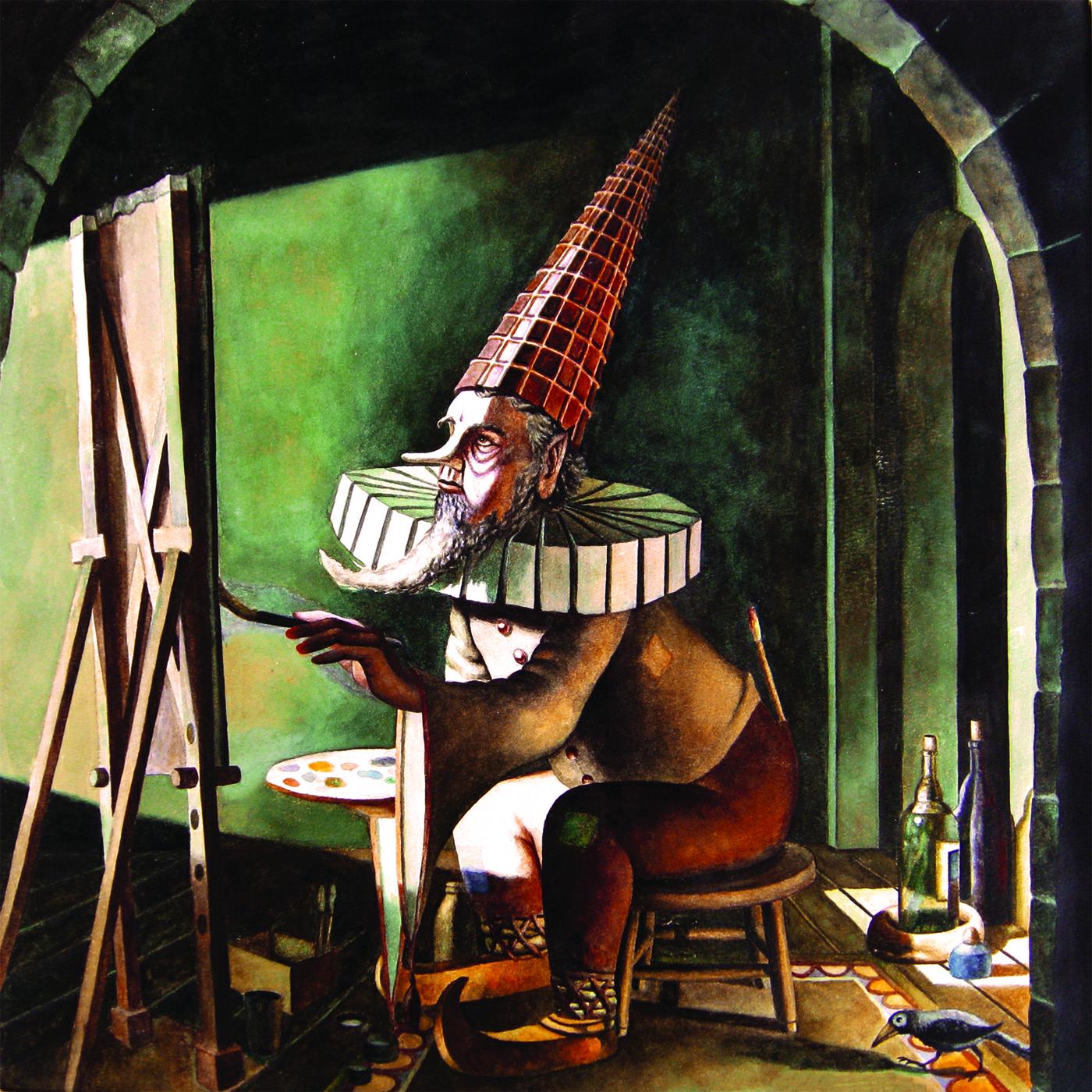 From Sweden, In The Labryinth combine Folk, Psychedelic and Progressive Rock influences with a passion for Indian/Middle Eastern music. To date they have released three full length albums – Garden Of Mysteries (1996), Walking On Clouds (1999), and Dryad (2002). Having been out of print for several years, Garden Of Mysteries, originally released by APM, has now been reissued by Transubstans Records.
From Sweden, In The Labryinth combine Folk, Psychedelic and Progressive Rock influences with a passion for Indian/Middle Eastern music. To date they have released three full length albums – Garden Of Mysteries (1996), Walking On Clouds (1999), and Dryad (2002). Having been out of print for several years, Garden Of Mysteries, originally released by APM, has now been reissued by Transubstans Records.
 From Sweden, In The Labryinth combine Folk, Psychedelic and Progressive Rock influences with a passion for Indian/Middle Eastern music. The band is headed up by Peter Lindahl and to date have released three full length albums – Garden Of Mysteries, originally released in 1996 and now reissued by Transubstans Records (see accompanying review), Walking On Clouds (1999), and Dryad (2002). One Trail To Heaven is a 13 track collection that consists of songs from the three albums, alternate versions of songs from those albums, two previously unreleased songs, and two contributions the band made to compilation albums.
From Sweden, In The Labryinth combine Folk, Psychedelic and Progressive Rock influences with a passion for Indian/Middle Eastern music. The band is headed up by Peter Lindahl and to date have released three full length albums – Garden Of Mysteries, originally released in 1996 and now reissued by Transubstans Records (see accompanying review), Walking On Clouds (1999), and Dryad (2002). One Trail To Heaven is a 13 track collection that consists of songs from the three albums, alternate versions of songs from those albums, two previously unreleased songs, and two contributions the band made to compilation albums.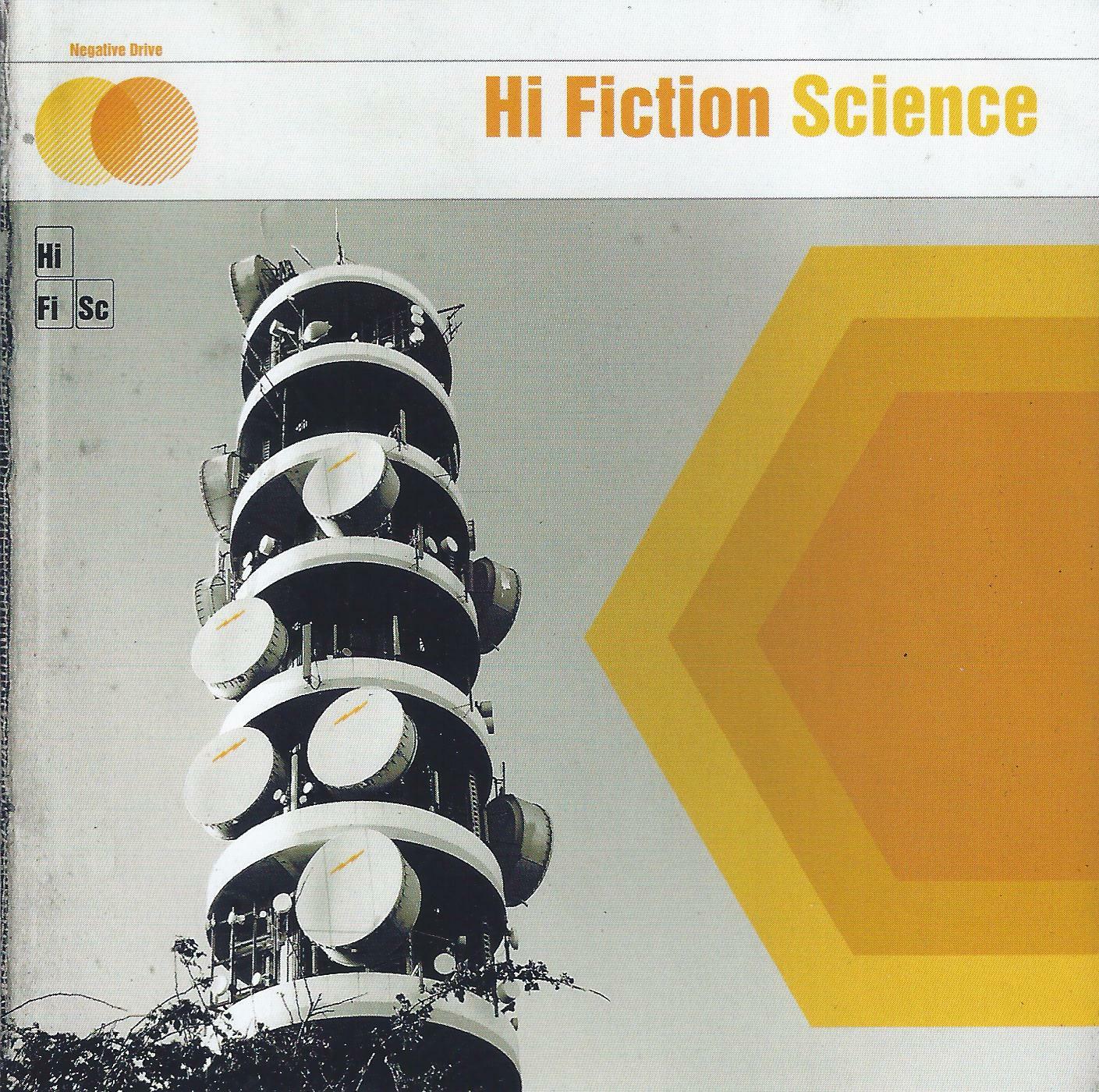 From Bristol, UK, Hi Fiction Science are the quintet of Maria Charles on guitar and vocals, Jeff Green on bass, keyboards and percussion, James McKeown on guitar, keyboards and percussion, Matt Rich on keyboards and samples, and Aidan Searle on drums and percussion.
From Bristol, UK, Hi Fiction Science are the quintet of Maria Charles on guitar and vocals, Jeff Green on bass, keyboards and percussion, James McKeown on guitar, keyboards and percussion, Matt Rich on keyboards and samples, and Aidan Searle on drums and percussion. Black Space Riders are a German dual guitar, bass, drums and vocals quartet and Light Is The New Black is the follow-up to their self-titled 2010 debut (see AI #42). The core of their style is heavy stoner rock and metal, with nods to psychedelia and space rock. Much of the Space is thematic, with cosmic song titles and the album is sub-titled Songs about luminaries, black holes, hope and loss in outer space. And the album is full of effects that add a spaced out atmosphere to the music and help Black Space Riders transcend what could easily be a standard stoner-metal style.
Black Space Riders are a German dual guitar, bass, drums and vocals quartet and Light Is The New Black is the follow-up to their self-titled 2010 debut (see AI #42). The core of their style is heavy stoner rock and metal, with nods to psychedelia and space rock. Much of the Space is thematic, with cosmic song titles and the album is sub-titled Songs about luminaries, black holes, hope and loss in outer space. And the album is full of effects that add a spaced out atmosphere to the music and help Black Space Riders transcend what could easily be a standard stoner-metal style.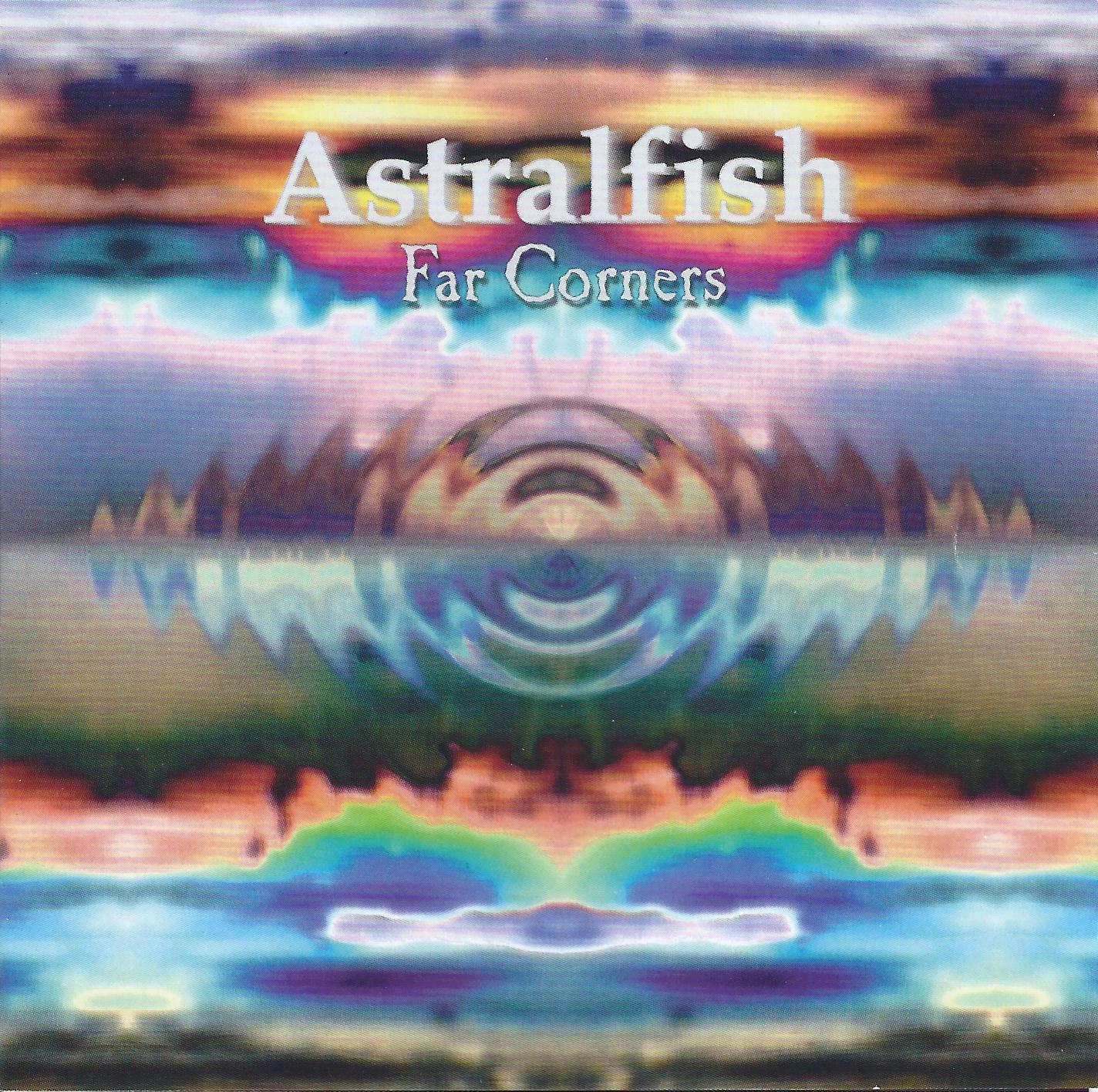 Astralfish is the latest project from Don Falcone and Bridget Wishart. Don has a lengthy resume, including Spaceship Eyes, Thessalonians, Grindlestone, and Quiet Celebration, but Space Rock fans might know him primarily as commander of Spirits Burning, which for nearly 13 years has been releasing collaboration albums that bring together a global assortment of luminaries from the Space Rock and Prog Rock world. Bridget was a member of Hawkwind from 1989-1991, and two Spirits Burning albums – Earth Born and Bloodlines – were credited to Spirits Burning and Bridget Wishart. In fact, Don is responsible for having coaxed Bridget out of retirement in 2002, and what initially started as contributing to a Spirits Burning album has blossomed into a flurry of activity and contributions to many band’s albums. For a healthy dose of Bridget’s music over the past decade, go to the Aural Innovations Space Rock Radio page and scroll down to show #268, which is an all Bridget Wishart special.
Astralfish is the latest project from Don Falcone and Bridget Wishart. Don has a lengthy resume, including Spaceship Eyes, Thessalonians, Grindlestone, and Quiet Celebration, but Space Rock fans might know him primarily as commander of Spirits Burning, which for nearly 13 years has been releasing collaboration albums that bring together a global assortment of luminaries from the Space Rock and Prog Rock world. Bridget was a member of Hawkwind from 1989-1991, and two Spirits Burning albums – Earth Born and Bloodlines – were credited to Spirits Burning and Bridget Wishart. In fact, Don is responsible for having coaxed Bridget out of retirement in 2002, and what initially started as contributing to a Spirits Burning album has blossomed into a flurry of activity and contributions to many band’s albums. For a healthy dose of Bridget’s music over the past decade, go to the Aural Innovations Space Rock Radio page and scroll down to show #268, which is an all Bridget Wishart special.
 Strange – “Translucent World” (Outer Galaxy Records 1973, later reissued by Psycho Records and then Akarma Records)
Strange – “Translucent World” (Outer Galaxy Records 1973, later reissued by Psycho Records and then Akarma Records) Strange – “Raw Power” (Outer Galaxy Records 1976, later reissued by Psycho Records and then Akarma Records)
Strange – “Raw Power” (Outer Galaxy Records 1976, later reissued by Psycho Records and then Akarma Records) Terry Brooks & Strange – “To Earth With Love” (Star People Records 1980)
Terry Brooks & Strange – “To Earth With Love” (Star People Records 1980) Terry R. Brooks – “Earth To Infinity” (Strange Records 1995)
Terry R. Brooks – “Earth To Infinity” (Strange Records 1995) Terry Brooks & Strange – “Rock Force” (Strange Records, limited edition of 100 CDs)
Terry Brooks & Strange – “Rock Force” (Strange Records, limited edition of 100 CDs) Terry R. Brooks & Strange – “Rock The World” (Akarma Records 1998, AK006)
Terry R. Brooks & Strange – “Rock The World” (Akarma Records 1998, AK006) Father Rock (Novel, Trafford Publishing 2007)
Father Rock (Novel, Trafford Publishing 2007) Until I picked this CD to review for Aural Innovations, I hadn’t even heard of this Dave Schmidt (aka Sula Bassana) side project, band, etc. Flaming Lake is a recording of a live performance that took place on July 2, 2011 at the Open Air Festival in Battenberg, Germany. As to anyone who has read my CD reviews before – I am a huge fan of live releases as such. Best described as long-winded instrumental psychedelic jams with some superb improvisation. The CD is a limited edition of just 250 copies and the Sulatron Records site indicates that the vinyl pressing edition is already sold-out. Four lengthy tracks to soak your (already) damaged senses into – like for example the disc’s opener The Cosmic Creator (17:30) is a fine instrumental work-out with awesome passages and fuzz guitar fully put to good use; and the title cut Flaming Lake (16:20) is a definite over-the-top German space rock piece that will have fans of early Hawkwind and Guru Guru surely sitting up and taking notice. The longest running tune Lost And Found (23:43) starts off a bit similar to say, Monster Magnet (at least, I thought so) without the vocals and later had developed into like a Jimi Hendrix guitar ripping shred-fest. The finale to all this galactic bliss winds down with Burning Battenberg (18:43) which showcases Electric Moon’s melodic side.
Until I picked this CD to review for Aural Innovations, I hadn’t even heard of this Dave Schmidt (aka Sula Bassana) side project, band, etc. Flaming Lake is a recording of a live performance that took place on July 2, 2011 at the Open Air Festival in Battenberg, Germany. As to anyone who has read my CD reviews before – I am a huge fan of live releases as such. Best described as long-winded instrumental psychedelic jams with some superb improvisation. The CD is a limited edition of just 250 copies and the Sulatron Records site indicates that the vinyl pressing edition is already sold-out. Four lengthy tracks to soak your (already) damaged senses into – like for example the disc’s opener The Cosmic Creator (17:30) is a fine instrumental work-out with awesome passages and fuzz guitar fully put to good use; and the title cut Flaming Lake (16:20) is a definite over-the-top German space rock piece that will have fans of early Hawkwind and Guru Guru surely sitting up and taking notice. The longest running tune Lost And Found (23:43) starts off a bit similar to say, Monster Magnet (at least, I thought so) without the vocals and later had developed into like a Jimi Hendrix guitar ripping shred-fest. The finale to all this galactic bliss winds down with Burning Battenberg (18:43) which showcases Electric Moon’s melodic side.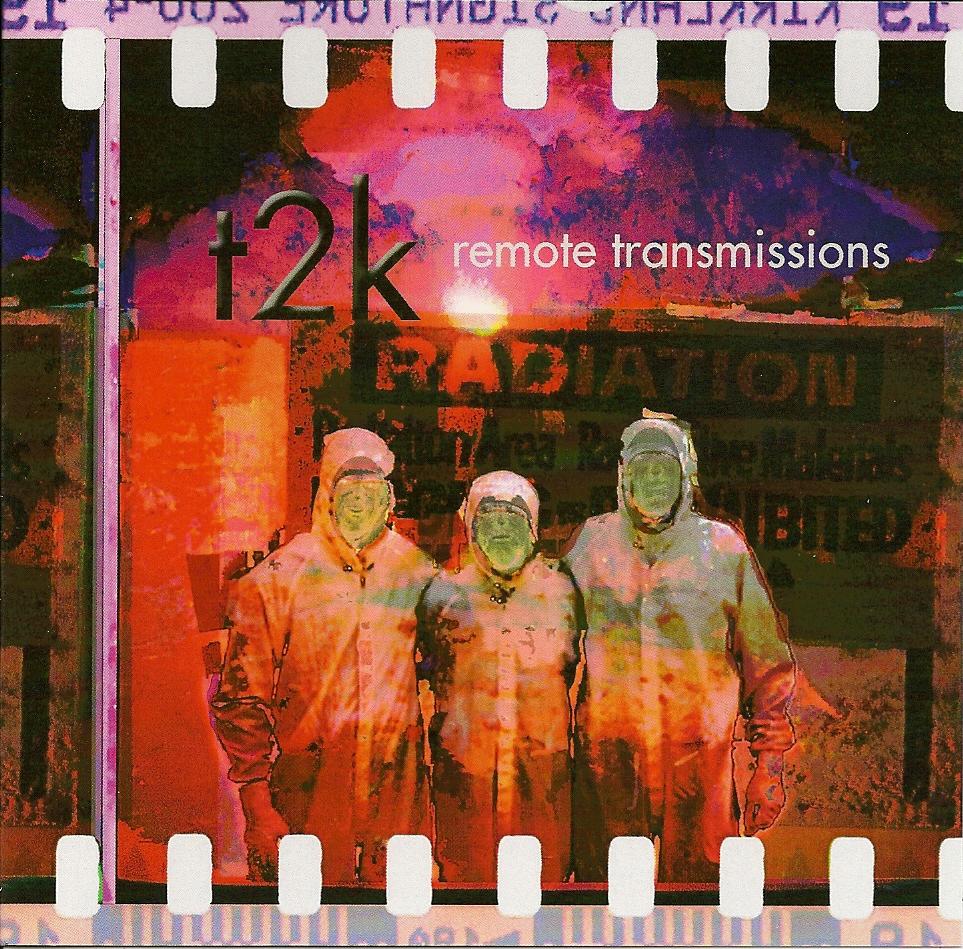 The name of t2k’s debut album Remote Transmissions is singularly appropriate, as the band were never all in the same studio, or even the same state, when it was being recorded. Instead, sound files were passed through cyberspace between the different players who added their own parts before assembling and mixing the whole album using Protools and Logic 9 systems. The project came about when Kevin Gerety (8-string fretless Warr guitar and fretless bass) and Kevin StClair (Roland v-drums), who had been jamming in their Connecticut basement, hooked up with Colorado-native Timmy C Pitschka (6 & 7 string guitars and piano) over the internet and started working as a trio by sharing files to create the basis for the album. The result is 70 minutes of improvised music spread across eight tracks which range from ambient soundscapes to a kind of metal-dub fusion.
The name of t2k’s debut album Remote Transmissions is singularly appropriate, as the band were never all in the same studio, or even the same state, when it was being recorded. Instead, sound files were passed through cyberspace between the different players who added their own parts before assembling and mixing the whole album using Protools and Logic 9 systems. The project came about when Kevin Gerety (8-string fretless Warr guitar and fretless bass) and Kevin StClair (Roland v-drums), who had been jamming in their Connecticut basement, hooked up with Colorado-native Timmy C Pitschka (6 & 7 string guitars and piano) over the internet and started working as a trio by sharing files to create the basis for the album. The result is 70 minutes of improvised music spread across eight tracks which range from ambient soundscapes to a kind of metal-dub fusion.  From Sweden, Knez Rosén is Igor Knez and Hans Rosén. Knez migrated to Sweden as a 12 year old, where improvised jazz and the traces of melancholia in Swedish folk music deepened his musical tastes. As a young man in the 70’s/90’s Knez was a guitarist in a number of bands playing acoustic and electronic music combining jazz, rock, funk and folk music. Rosén’s first musical memories are of his mother and grandmother singing folk songs, and as a teenager in the late 70’s, punk rock lit a flame that still remains. From that time on Rosén has played with a number of bands with music styles from vibrant rock to afro and reggae.
From Sweden, Knez Rosén is Igor Knez and Hans Rosén. Knez migrated to Sweden as a 12 year old, where improvised jazz and the traces of melancholia in Swedish folk music deepened his musical tastes. As a young man in the 70’s/90’s Knez was a guitarist in a number of bands playing acoustic and electronic music combining jazz, rock, funk and folk music. Rosén’s first musical memories are of his mother and grandmother singing folk songs, and as a teenager in the late 70’s, punk rock lit a flame that still remains. From that time on Rosén has played with a number of bands with music styles from vibrant rock to afro and reggae.  Amber was the English psychedelic folk duo of Keith “Mac” MacLeod and Julian McAllister, and these are the only recordings they made in 1970/1971. MacLeod (guitar) and McAllister (vocals) had known each other since the early 60’s, had met for jam sessions and traveled through the world independently of each other. MacLeod played second guitar with Donovan on his first national tour and the sitar used on this album was lent by Donovan who had been given the instrument by George Harrison.
Amber was the English psychedelic folk duo of Keith “Mac” MacLeod and Julian McAllister, and these are the only recordings they made in 1970/1971. MacLeod (guitar) and McAllister (vocals) had known each other since the early 60’s, had met for jam sessions and traveled through the world independently of each other. MacLeod played second guitar with Donovan on his first national tour and the sitar used on this album was lent by Donovan who had been given the instrument by George Harrison.